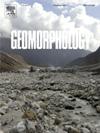比利牛斯山脉中南部bonab山谷(Marimanha Massif)末次消冰期的冰川和冰缘动力学
IF 3.1
2区 地球科学
Q2 GEOGRAPHY, PHYSICAL
引用次数: 0
摘要
在这项研究中,我们结合地貌测绘和宇宙射线曝光测年方法,重建了Marimanha地块(上Noguera Pallaresa山谷,比利牛斯山脉中南部)的bonab本文章由计算机程序翻译,如有差异,请以英文原文为准。
Glacial and periglacial dynamics during the last deglaciation in the Bonabé Valley (Marimanha Massif), central southern Pyrenees
In this study we reconstruct the deglaciation of the Bonabé valley in the Marimanha massif (upper Noguera Pallaresa valley, central southern Pyrenees) by combining geomorphological mapping and cosmic-ray exposure dating methods applied to a set of 17 samples from moraines, rock glacier boulders and glacially-polished surfaces. This valley includes eight moraine systems and two rock glaciers, and the geochronological results reveal one of the most complete sequences of glacial and periglacial phases documented in the Pyrenees, from the Heinrich Stadial 1, Bølling-Allerød and Younger Dryas events to the onset of the Holocene. The cooling recorded during the Heinrich Stadial 1 generated three phases of glacier advance/still stands between 17.3 and 15.3 ka, with the development of 2-4 km long alpine glaciers. The Bølling-Allerød interstadial entailed a rapid process of valley and cirque deglaciation around 15-13 ka, and the replacement of glacial processes by periglacial dynamics characterised by the formation of polygenetic rock glaciers. The Younger Dryas favoured both the development of the upper ridges of a rock glacier that stabilised around 12.3 ka, and the formation of new small cirque glaciers that built moraines which stabilised around 11 ka.
求助全文
通过发布文献求助,成功后即可免费获取论文全文。
去求助
来源期刊

Geomorphology
地学-地球科学综合
CiteScore
8.00
自引率
10.30%
发文量
309
审稿时长
3.4 months
期刊介绍:
Our journal''s scope includes geomorphic themes of: tectonics and regional structure; glacial processes and landforms; fluvial sequences, Quaternary environmental change and dating; fluvial processes and landforms; mass movement, slopes and periglacial processes; hillslopes and soil erosion; weathering, karst and soils; aeolian processes and landforms, coastal dunes and arid environments; coastal and marine processes, estuaries and lakes; modelling, theoretical and quantitative geomorphology; DEM, GIS and remote sensing methods and applications; hazards, applied and planetary geomorphology; and volcanics.
 求助内容:
求助内容: 应助结果提醒方式:
应助结果提醒方式:


